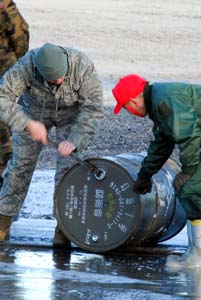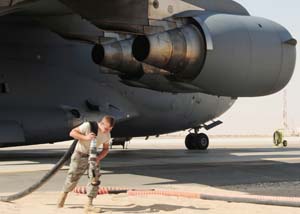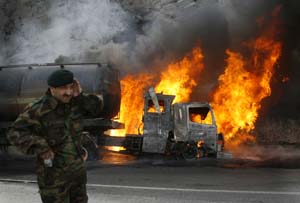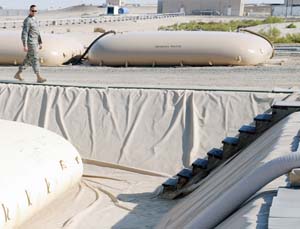When fuel starts flowing into an Air Force aircraft—whether it comes from an on-base refueling point or an airborne tanker—it is the last, and perhaps easiest, step in a long, complex, and sometimes dangerous process.
Getting fuel to Air Force units around the world often brings into play an array of US agencies and commands, personnel from at least three of the armed services, and armies of civilian contractors across many nations. At various stages, the fuel can be moved by nearly every means of transport: pipelines, ships, trains, trucks, fixed wing aircraft, and helicopters.
The challenge is magnified by the scope and breadth of the enterprise. The Defense Department is the world’s single largest consumer of fuel, spending more than $20 billion a year to purchase 4.6 billion gallons of fuel and transport it across the world. The Air Force uses 52 percent of that total—about 2.4 billion gallons a year.
The burdens are particularly great in US Central Command, which is the overseer of two major conflicts and, in the case of Afghanistan, must use especially difficult and dangerous supply routes that put American lives at risk.
US Pacific Command must contend with vast distances over open ocean.
 |
A1C John Nguyen inspects a quart of fuel, checking it for impurities. (USAF photo by A1C Courtney Witt) |
The Air Force commands in those two theaters use half the service’s total, about 1.22 billion gallons of all types of fuels annually, according to logistics experts in those commands.
The key to this massive operation is a cadre of a few thousand Air Force logisticians and petroleum, oil, and lubricants (POL) specialists—uniformed and civilian—who deal with problems that range from calculating and ordering needed supplies at the start to pumping fuel into aircraft at the end.
SMSgt. Edwin Ludwigsen, Pacific Air Forces fuels function manager at PACAF headquarters in Hawaii, said that he and his fellow POL professionals “go to great lengths to make sure we never spill it, never contaminate it, and by all means, never run out of it.”
That last requirement can be especially challenging in Afghanistan.
Kenneth Murphy, the fuels manager for US Air Forces Central (AFCENT) at Shaw AFB, S.C., contends that Afghanistan is the toughest logistics challenge he has ever faced, mostly because the country’s infrastructure is so poor.
“They have no transport system, no roadways for long-hauling fuel, no refined fuel processing,” Murphy reported, “so a lot of the fuel has to be brought in through GLOCs [ground lines of communication] from other countries. The coordination to get fuel across the borders, across the mountains, across the terrain, really generates some extreme challenges.”
In AFCENT countries, fuel can be moved to the bases in two ways, Murphy said. If the host nation has the infrastructure, the trucks, and the storage capability, AFCENT will contract with it for support, he said. “That saves us from having to bring in equipment and personnel to handle that convoy resupply mission.”
A Long, Hard Haul
In countries that do not have the right infrastructure, the Army is leaned on heavily for resupply, because of its bases and the inland distribution responsibilities, he continued. “They’ll establish fuel hubs at the main bases, and then they’ll make pushes out from those hubs to other locations,” Murphy said.
Because Afghanistan is landlocked, most of the fuel and other bulk supplies for it arrive at the port in Karachi, Pakistan, more than 550 miles over land from Kandahar. Moving supplies over that route normally takes 14 to 20 days, a Marine Corps CENTCOM logistician said. Bagram Airfield, the Air Force’s largest base in Afghanistan, is more than 300 miles farther north.
 |
|
The route from Karachi goes through the Federally Administered Tribal Areas, where Islamic militants, including the Taliban and al Qaeda, often have more control than the Pakistani government, and the road into Afghanistan goes through high mountain passes, including the notorious Khyber Pass.
Because of that rugged terrain and frequently bad weather, Murphy said, “the whole mission profile causes a lot of logistics challenges.” Fuel convoys going across the mountains, he said, run into heavy snow up on the top. As they come down the mountain, the snow turns to rain, leading to washed out roads, flooding in certain areas, and problems accessing bridges. “Then farther down in other regions, they can be faced with extreme heat, desert-type conditions. So we can have one convoy mission go through all three extreme weather conditions in one day.” Those conditions result in frequent truck breakdowns and accidents. In northern Pakistan and in Afghanistan, even greater danger is posed by the militants, who frequently attack convoys or plant improvised explosive devices, or IEDs, in the roads.
Similar threats face supply convoys moving from the main bases or hubs to smaller operating bases inside Afghanistan.
An Army study that looked at the resupply challenge in 2003-07—before the Taliban insurgency escalated to its current levels—found that one person was killed or wounded for every 24 fuel convoys moving in Afghanistan.
Virtually all the supply runs from Karachi into Afghanistan are conducted by Pakistani or Afghan truckers, contracted by the Army or DLA. A Congressional study released in June said millions of dollars that US authorities pay to have fuel and other supplies moved from Karachi to Afghanistan go to bribe Afghan warlords, and possibly the Taliban, to prevent attacks.
Because of the physical difficulty and militant threats to the logistics route through Pakistan, US authorities have been working to expand a northern route that can bring supplies by rail or air from Europe through some of the Central Asian countries north of Afghanistan.
That route could be a better way of getting bulk supplies, including fuel, to Bagram, north of Kabul.
So far, the northern route handles only a small percentage of the supplies for US and coalition forces in Afghanistan, but the Pentagon is anticipating awarding a new multimillion-dollar contract for supplying fuel to Bagram, requiring that it be brought in from the north.
 |
|
The northern supply line is currently used to provide fuel to the US operations at Manas, which has been threatened by the political turmoil in Kyrgyzstan, as well as Russian pressure on the government to remove the US presence from what Moscow still considers its sphere of influence.
Projecting the Requirements
Kyrgyzstan’s government, which took over in a coup in April, has agreed to renew the US lease for Manas. Even so, the Pentagon has called excessive the $100 million-plus fee it has been paying for fuel.
The new Kyrgyz government announced in June it was establishing a state-owned firm that could supply the fuel to Manas.
Getting fuel into Iraq had been an easier task because of local production and better infrastructure, Murphy said, but the rapid drawdown of forces there is creating new challenges.
As the US troops withdraw, CENTCOM is closing some of the hubs that had supported Air Force units in Iraq, Murphy said. He added that where one hub would support four bases, now one hub may be supporting five or six—a problem that could get worse as the US presence is declining rapidly.
Although PACAF has fewer problems with infrastructure, it faces the task of moving vast quantities of fuel over great distances and to some rather isolated locations.
The process used by the fuel supply staffs across the Air Force is designed to ensure that the users’ requirements are met, despite obstacles. The process begins with the fuels management team at each location calculating expected fuel consumption, based on the types of aircraft and ground support requirements and projected flight operations, according to fuel specialists. That calculation is usually performed on a quarterly basis, and includes a reserve that ensures the ability to adjust to surges or disruptions to fuel resupply, Murphy said.
 |
|
The projected requirements for each location are compiled into a total for each of the Air Force theater commands, and that is submitted to the buyer, the Defense Logistics Agency Energy, a component of the Defense Logistics Agency (DLA).
“They’re the ones doing the purchasing,” Murphy said. “They’re the ones dealing with industry to reserve the fuel coming off the refineries. To be able to get fuel for our operations, we have to be looking down the road. We have to put a marker into the commercial system, so that the fuel that gets produced three months from now will be available for us. And that’s DLA. They handle all of that.”
DLA, through DLA Energy, contracts for the fuel to be delivered to each base, where the POL airmen receive fuel and account for it while in storage, Ludwigsen said. But DLA Energy still owns the fuel even though it is being stored on the Air Force base, he noted. The Air Force does not own the fuel until it is actually issued to the aircraft.
The Air Force buys the fuel at that point by use of an AIR (Aviation Into Plane Reimbursement) card that provides the billing information for the aircraft’s unit, Ludwigsen explained.
Like a credit card at a civilian gas station, the AIR card usually “can be swiped by automated equipment on the refueling vehicle.”
But actually getting the fuel to the Air Force facility needing it can be a complicated process that can involve a number of other government and civilian entities.
For most of the fuel needed by AFCENT and PACAF, part of the movement is under the control of US Transportation Command, which has ground and sea components in addition to Air Mobility Command.
Distribution
The Army’s Surface Deployment and Distribution Command handles fuel movement by pipeline or rail within the United States and by a variety of means overseas. Because of their locations, most of PACAF’s fuel (and a lot of AFCENT’s) is transported to the host countries under authority of the Navy’s Military Sealift Command. MSC owns three large tanker ships, which can carry 238,400 barrels of fuel each, and charters a shallow draft 36,000-barrel tanker that is used to move fuel intratheater for Japan and South Korea.
All of these ships are crewed by US merchant seamen. MSC also can hire US-flagged vessels to meet the military’s needs.
In PACAF, the fuel goes to 10 major bases in South Korea, Japan, Guam, Wake Island, Hawaii, and Alaska, plus four smaller South Korean facilities and 15 remote Alaskan radar sites. MSgt. Joel Brown, PACAF fuels operations superintendent, said Guam is the command’s largest fuel account, since it is a vital trans-Pacific refueling stop and a heavily used staging base. On average, Andersen AFB, Guam, issues more than 50 million gallons of jet fuel annually, but can store up to 66 million gallons, Brown said.
 |
|
AFCENT supports 14 bases in eight countries, Murphy said. Those bases include well-equipped facilities in Iraq, Kuwait, and other Persian Gulf countries; large bases at Balad in Iraq and Kandahar and Bagram in Afghanistan; and some small, austere locations throughout that country. The command also supports the US operations at Manas in Kyrgyzstan, a key supply waypoint and air tanker base.
Although the primary fuel used by both commands is JP-8 for fixed wing aircraft and helicopters, they also require significant quantities of diesel for ground vehicles and generators, and small amounts of standard automotive motor gasoline (Mogas) for a limited number of vehicles. AFCENT also requires aviation gasoline (Avgas) for some of the smaller remotely piloted aircraft operating in theater. PACAF issues more than 285 million gallons of jet fuel annually, about 40 million gallons of diesel, and about two million gallons of Mogas, Ludwigsen said.
 |
|
AFCENT requires a total of 878 million gallons of jet fuel, diesel, and Mogas a year for Afghanistan, Iraq, and for theater support bases, which are outside those countries but support both, Murphy said. The command also uses more than 60,000 gallons of Avgas a month, which is tough to manage because it is not produced within the CENTCOM area of responsibility and has to be brought in, mainly from Europe, Murphy said.
Distributing Avgas in country also is a problem, because many of the RPAs are based in austere locations, Murphy added. Avgas is normally brought into Afghanistan in 6,400-gallon bulk fuel containers, and then put into 500-gallon collapsible rubber bags, called blivets, for shipment to the point of use. That may require what Murphy called a “stair step” process in which a C-17 takes a number of blivets to a larger forward operating location, from where some will be carried by helicopter as sling loads to more remote locations.
For PACAF, most of their fuel arrives in the host country, or island, by tanker ships. It then is transported to the Air Force facility by established transportation systems, such as pipelines, rail, or trucks, which frequently are commercially operated. On the base, the fuel is stored in bulk storage tanks until an aircraft requests fuel, Lugwigsen said. Aircraft can be serviced using an R-11 refueling vehicle, holding 6,000 gallons. If a base has a built-in fuel hydrant system, refueling can be performed using an R-12 hydrant servicing vehicle, basically a pump moving fuel between the in-ground system and the aircraft.
Otto Kreisher is a Washington, D.C.-based military affairs reporter and longtime contributor to Air Force Magazine. His most recent article, “The Aircraft Losses Mount,” appeared in the February issue.

